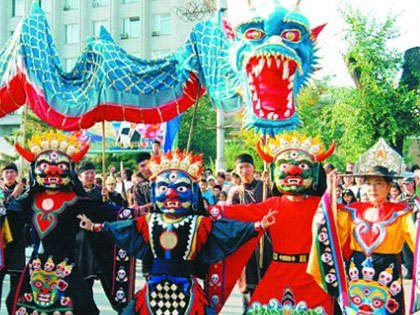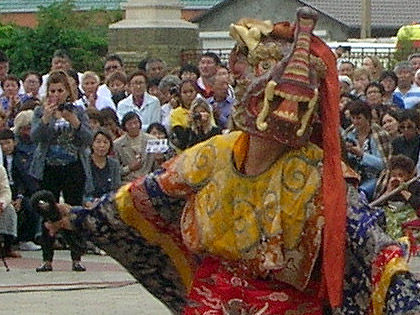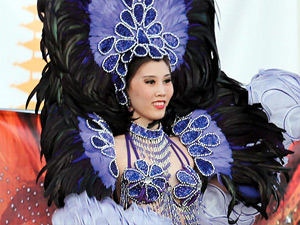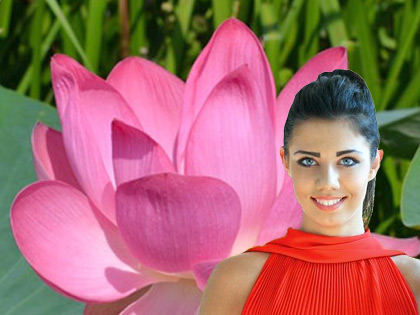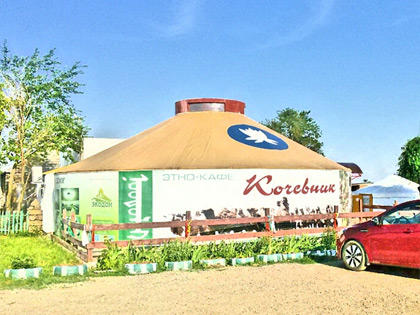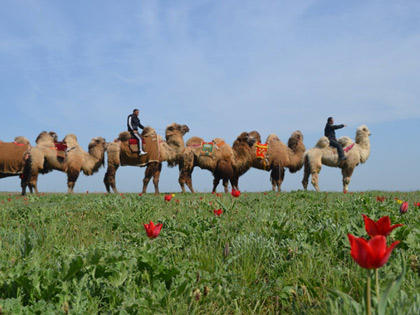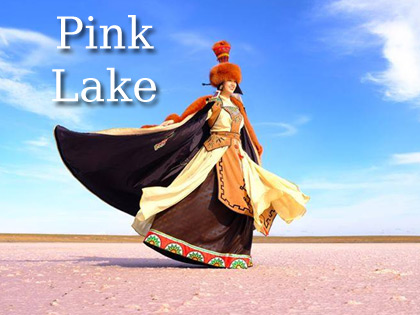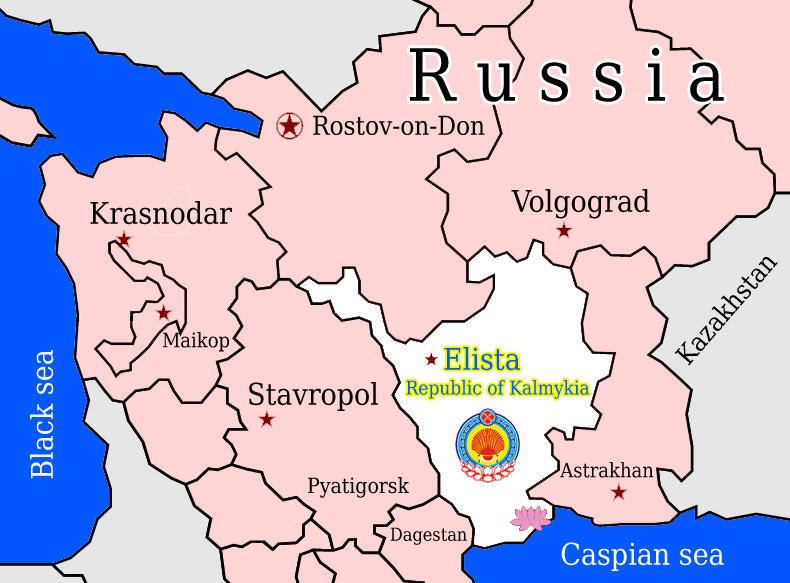The current state of Buddhism in Kalmykia
 Chagdir Sandzhiev. The current state of Buddhism in Kalmykia
Chagdir Sandzhiev. The current state of Buddhism in Kalmykia
It’s been more than 20 years since the collapse of the USSR and the beginning of the period of genuine religious freedom in Russia. Great changes happened both in the country as well as in the minds and hearts of the citizens during this period. People became interested in religion, and as a consequence felt the need to revive traditional religious systems. These positive changes also happened in the only Buddhist republic of the European part of Russia – in Kalmyk Republic.
For the first time Oirats – Western Mongols, the ancestors of the Kalmyks, gained access to the Tibetan Buddhism in the XIII century, but during that period Buddhism was not widespread. It took firmer root at the end of 16 – early 17 century, during the rise of Gelug tradition, which came directly from Tibet and partly through Mongolia. A prominent contribution was made by a great teacher, humanist, scientist Lama Zaya Pandita. Zaya Pandita studied in Tibet for more than twenty years, took a full course of Buddhist philosophy, and became the founder of national alphabet and translated a large body of Buddhist literature into his native language. On behalf of the Dalai Lama Zaya Pandita began to preach the teachings of the Buddha to his people in western Mongolia, twice he came to the banks of the Volga.
 At the beginning of the 17 century, more than four hundred years ago, the ancestors of the Kalmyks separated from Oirats of Dzhungaria and moved into the area between the Volga and the Don to the north of the Caspian Sea. They brought Buddhist religious system, rooted in ancient India. The history of Buddhism in Russia began at that time. Buddhist authority was so great that the secular leaders of the Kalmyk people – Khans – were considered legitimate only from the moment when Khan’s authority was recognized by the Dalai Lama from Tibet.
At the beginning of the 17 century, more than four hundred years ago, the ancestors of the Kalmyks separated from Oirats of Dzhungaria and moved into the area between the Volga and the Don to the north of the Caspian Sea. They brought Buddhist religious system, rooted in ancient India. The history of Buddhism in Russia began at that time. Buddhist authority was so great that the secular leaders of the Kalmyk people – Khans – were considered legitimate only from the moment when Khan’s authority was recognized by the Dalai Lama from Tibet.
Despite the vast distances between Kalmykia and Tibet, inconvenience and even danger to life associated with poor development of the road system and the primitive means of transport of that time, many of the Kalmyk people considered making pilgrimage to the “Land of Snow” as a sacred duty, because Tibet was a spiritual homeland to Kalmyks.
 Kalmyk Lamas studied in Tibetan monasteries, and this tradition was preserved until the first half of last century. Some of the best ethnic Kalmyk lamas received the highest academic degrees, and were even teachers of the Dalai Lamas. One of the last Kalmyk lamas, who managed to complete a full course of the Buddhist Sciences before the “Iron Curtain” and received the title of Geshe Lharamba was Geshe Vangyal. He failed to return home, because at that time the Soviet Union pursued active anti-religious policy. He remained in Tibet, visited India, and then on behalf of the Dalai Lama went to the United States, where he founded one of the first Buddhist temples and preached the oldest religion of the world in America. Today many of Geshe Vangyal’s students continue his work, among them there are people known outside the U.S. By the way, the current leader of the Buddhists of Kalmykia Shadjin lama of the Kalmyk people Telo Tulku Rinpoche is an U.S. citizen of Kalmyk origin. He was recognized as the reincarnation of a great Buddhist teacher Tilopa by His Holiness the Dalai Lama 14.
Kalmyk Lamas studied in Tibetan monasteries, and this tradition was preserved until the first half of last century. Some of the best ethnic Kalmyk lamas received the highest academic degrees, and were even teachers of the Dalai Lamas. One of the last Kalmyk lamas, who managed to complete a full course of the Buddhist Sciences before the “Iron Curtain” and received the title of Geshe Lharamba was Geshe Vangyal. He failed to return home, because at that time the Soviet Union pursued active anti-religious policy. He remained in Tibet, visited India, and then on behalf of the Dalai Lama went to the United States, where he founded one of the first Buddhist temples and preached the oldest religion of the world in America. Today many of Geshe Vangyal’s students continue his work, among them there are people known outside the U.S. By the way, the current leader of the Buddhists of Kalmykia Shadjin lama of the Kalmyk people Telo Tulku Rinpoche is an U.S. citizen of Kalmyk origin. He was recognized as the reincarnation of a great Buddhist teacher Tilopa by His Holiness the Dalai Lama 14.
Before the Soviet period, there were more than a hundred large and small Buddhist temples in Kalmykia. Unfortunately, as a result of the ruthless actions of the Soviet regime each and every temple was barbarously destroyed, thousands of lamas were repressed, many of them – were shot. Despite these harsh measures, Buddhism was ineradicable from the minds of people. Very few Buddhist lamas were left, and they were guarding the sanctity of the Buddhist teaching as if it was a flickering flame of a lantern. They had an indisputable authority over simple laymen, who, despite many years of active massive anti-religious propaganda, did not forget the religion of their ancestors. For a vivid example take a well-known fact that even in the days of unchallenged dominance of Soviet power, the Kalmyks annually celebrated their national holiday Zuul – the day when a great Buddhist reformer – Lama Tsongkapa – achieved Nirvana. This is the day when the Kalmyks celebrated and still celebrate the New Year.
In the late 1980-s, as a result of the policies of glasnost and perestroika, associated with the name of the Nobel Peace Prize winner Mikhail Gorbachev, after decades of oblivion first legitimate Buddhist communities appeared in Kalmykia. A big role in the revival of Buddhism in Kalmykia at the present stage was played by a visit of His Holiness the Dalai Lama 14 to Kalmykia in 1991 and 1992. In 1995, the first Buddhist temple after the Soviet period was built in Elista, the capital of Kalmykia. This was a landmark moment, a clear evidence of the irreversibility of positive changes.
At present there are more than thirty Buddhist organizations at the territory of Kalmykia, 27 of them belong to a Centralized religious organization “Buddhist Union of Kalmykia”, headed, as already mentioned, by Shadjin (Head) Lama of Kalmykia Telo Tulku Rinpoche. Over the past two decades more than 50 buddhist temples and prayer houses, over 30 stupas were built by believers, with the support and direct participation of the Sangha of Kalmykia.
 During the past five years the main Buddhist religious activity of Kalmykia has been concentrated in the Central khurul “Golden Abode of Buddha Shakyamuni”. The Khurul has taken firm leading positions in spreading the Dharma among the population of Republic. For example the Senior lama of Kalmykia, Geshe Tenzin Dugda holds monthly lectures on the basics of Buddhist philosophy, gives blessings of Buddhist deities. Also he has held retreats in the practice of Yamantaka, Vajrayoginya. Teacher Geshe Jampa delivered lectures on morality and secular ethics for students in urban and rural schools, as well as for college students and Kalmyk State University students.
During the past five years the main Buddhist religious activity of Kalmykia has been concentrated in the Central khurul “Golden Abode of Buddha Shakyamuni”. The Khurul has taken firm leading positions in spreading the Dharma among the population of Republic. For example the Senior lama of Kalmykia, Geshe Tenzin Dugda holds monthly lectures on the basics of Buddhist philosophy, gives blessings of Buddhist deities. Also he has held retreats in the practice of Yamantaka, Vajrayoginya. Teacher Geshe Jampa delivered lectures on morality and secular ethics for students in urban and rural schools, as well as for college students and Kalmyk State University students.
Multiple scientific conferences as well as lectures and training sessions for teachers of “Fundamentals of religious cultures and secular ethics” have been held on the basis of the Central khurul and the Ministry of Education of the Republic. Last summer, an international Buddhist Symposium took place in the “Golden Abode”, which brought together representatives of all Russian Buddhist republics and guests from abroad.
In 2006 at the initiative of Telo Tulku Rinpoche, Russian Buddhists for the first time held a Long Life Puja for Dalai Lama 14 in Dharamsala. Upon completion of the rituals the Head lama of Kalmykia requested His Holiness to kindly confer initiation of three major Buddhist tantric deities for Russian Buddhists. As a result, over the past three years the Dalai Lama was giving teachings for Russiain Buddhists in his personal monastery. They became so popular that His Holiness decided to give such teachings annually in the future.
In Buddhism in general and especially in the Gelug tradition a spiritual teacher is highly venerated. Over the years, the Central khurul has been organizing visits of high Buddhist teachers who gave Teaching in Elista, Kalmykia on the various parts of the Dharma. Among them are: the holder of the throne and the abbot of the largest Buddhist monastery in India Drepung Venerable Geshe-lharamba Lobsang Tenpa, abbot of Drepung Gomang, doctor of Buddhist philosophy Geshe Yonten Damcho, Kensur (former abbot) of the monastery Namgyal, one of the leading lamas of the Gelug school Jhado Tulku Rinpoche, the head of the Sakya tradition – Sakya Trizin Rinpoche, the head holder of the Ripa lineage of the Nyingma school venerable Namkha Drimed Rabjam Rinpoche, a well-known teacher Namkhai Norbu Rinpoche, director of the Library of Tibetan Works and Archives Geshe Lhakdor, the head of the Department of Translation Studies of the Central Institute of Higher Tibetan Studies Lobsang Norbu Shastri, the head of department of the Massachusetts Institute of Technology, a well-known Sanskrit scholar Tenzin Priyadarshi. Also lectures on the common ground between Buddhism and modern science were read by prominent Western Buddhist scholars Alan Wallace and Barry Kerzin. At various times lectures were given by Alexander Berzin.
In recent years the Central khurul has been developing international relations with Buddhist countries. We organized joint projects with the Dhammakaya Foundation (Thailand), Traditional Sangha of Sri Lanka, established contacts with Buddhist organizations in South Korea. Annually, monks from Gyudmed, Gomang and Gyuto monasteries come for the construction of mandala. In 2010, for the first time after more than 70-year pause, monks of Tantric Monastery Dzonkar Chode held a Tsam mystery in Kalmykia. Last year, 30 monks from Drepung Gomang Monastery were invited for the consecration of the Central khurul of Kalmykia.
Thus, as a result of dedicated efforts of the Head of the Kalmyk Buddhists Telo Tulku Rinpoche and the Sangha buddhism has a new stage of development in our country. At the moment, we have selected a priority for further development of Buddhism in Kalmykia and namely: the expansion and strengthening of the Sangha, the practical application of the Dharma among the laity, an explanation of basic terms and concepts of Buddhist philosophy to a wide range of believers, work with young people.
Central khurul is not only a place of pilgrimage for believers of the southern region of Russia, but because of its architectural beauty it has become a place of tourist destination, visited by tens of thousands of people every year.
The work done by the Head Lama of Kalmykia and by representatives of the Sangha gives us an opportunity to state that Kalmykia is a European centre of Buddhism.



